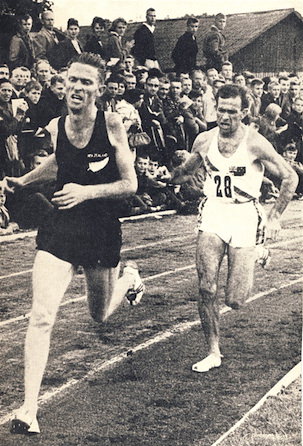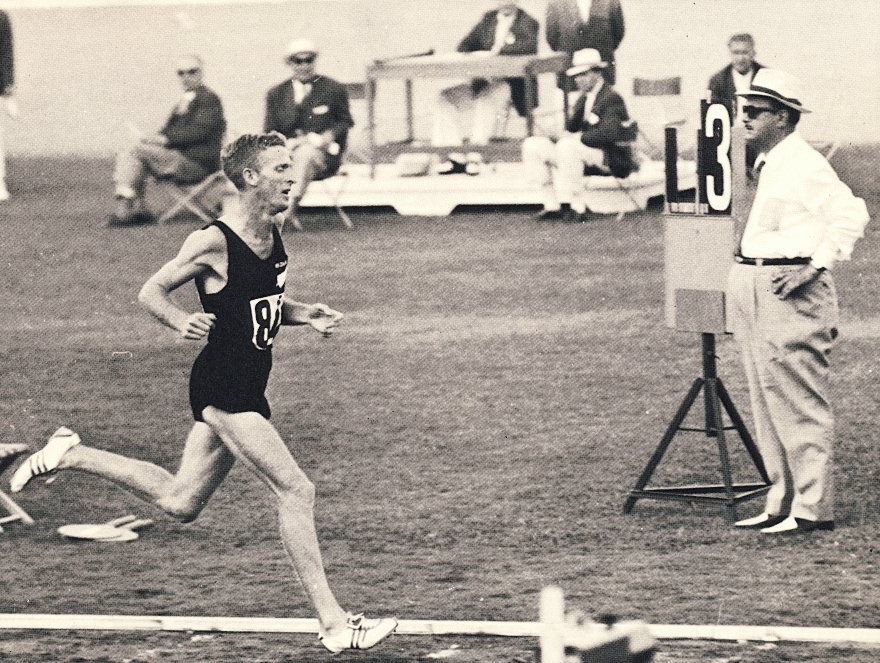MURRAY HALBERG: Profile
1933-2022
Playing rugby as a 17-year-old, New Zealand runner Murray Halberg injured his left shoulder in a tackle; his left arm was paralysed. Contact sports were now out of the question, but he was still able to run, holding his limp left arm “tucked up, pumping myself along with my right.” (A Clean Pair of Heels, 24) His local running coach saw Halberg’s potential, so he asked Arthur Lydiard to take over the coaching. Lydiard, who had not yet achieved his worldwide reputation, saw “astonishing tenacity” in his new pupil. (Arthur Lydiard, Master Coach, 43)
Halberg’s success came quickly. After winning New Zealand Junior titles in 1952, Halberg was national mile champion in 1954 and earned a place on the Empire Games team. He was thus privileged to run in the famous mile race between Bannister and Landy in Vancouver. After meeting Landy (“a perfect gentleman”) and finding him friendl--as opposed to the distant Bannister--Halberg and his colleague Baillie decided that they would help Landy if they could. The “Help-Landy plan” was carried out by Bill Baillie, who tried to set a fast pace for Landy. But Landy soon overtook him. Of course, 21-year-old Halberg was not yet in Landy’s or Bannister’s class: “I attempted to run as near the front as I could, but the pace and experience were too much for me. Although I stayed as close to Landy as possible, I was eventually passed by others and finished fifth.” (Halberg, Clean Pair of Heels, p.40) Still, he ran 4:07.2, his second-best time so far.
 |
| The toughness shows: Halberg passing Dave Power in a European race. Note his withered left arm. |
Halberg took it easy after this big race. He called 1955 “a year of consolidation and strength-building.” (CPH, p.45) Then, in the 1955-56 track season he ran a fast 800 in 1:51.7. Later, he ran a 4:02.4 Mile in Australia and then back in New Zealand a 13:38.8 Three Miles and a 4:01.8 Mile.
In 1956, he quit his job as a teacher, for which he had recently qualified, and took off with Bill Baillie and Bill Rodger to Australia, where the Olympics would be held later that year. After working at menial jobs and training in Australia, the best he could do before the Games was a 4:07 Mile. Nevertheless, his expectations were high for Melbourne.
But the Melbourne Olympics left him “dejected, bitter, borne down by a sense of failure.” (CPH, p.15) First, he barely made the final with a fourth-place 3:47.2 in the semi-final. After that experience he decided that the best way for him to win the final was to lead. Later he called this “the tactics of desperation.” (CPH, p.16) He led for the first lap and was then passed by Lincoln. Still, he managed to hold on to third at 800 (2:00.3). A lap later “black panic hit me.” (CPH, p.16). Halberg experienced the terror he’d felt eight year earlier when he had almost drowned. The whole field flew past him and he finished in 11th place with only the injured Lincoln behind him.
After this humiliating experience, Halberg need time to recover, so 1957 was a quiet year, although he improved his Three Mile time to 13:27.8. In early 1958 he competed regularly over Three Miles, running between 13:40 and 13:55 seven times. This was to be his event for the Empire Games.
Pirie and Ibbotson, silver and bronze medalists in Melbourne, were in the Empire Games field in Cardiff. Halberg stayed at the back for the first nine laps. The pace was faster than WR pace: 4:18 at the mile. When the pace slowed on lap 9, Halberg moved to the lead. Then with three laps to go, he took off, surprising all his opponents. “It was the easiest of wins because my break had caught them all between moods.” (CPH, p.72) His time was a breakthrough too: 13:14.75. Later he placed fifth in the Mile.
Following the Empire Games Halberg did his first European tour. He was invited to run in the Dublin Mile (See Great Races #12), where he ran a brilliant 3:57.5 for fourth place. Then he ran 3:39.4 for 1,500 in Gothenburg and 8:33 for Two Miles in London. After the European season, Halberg and Pirie did a sightseeing and running tour of South Africa.
The 1958-9 New Zealand track season was very quiet: he competed seriously only twice to take the Auckland and national Three–Mile titles. For the 1959-60 season, in preparation for the Rome Olympics, he ran a comfortable 13:11 Three Miles, a 4:03 Mile and then a 28:48 10,000. These times bode well for his Olympic 5,000 hopes.
 |
| A courageous move in the 5,000 Olympic final: Halberg out on his own with three laps to go. |
It was a much more mature Halberg that lined up for the 5,000 Olympic final in Rome. Rather than rushing into the lead as he had done in Melbourne, he started slowly: “I ran dead last and let the rest of the field carry me along.... It was almost as if I were watching the race from a detached position on the terraces. I seemed to have all the time in the world.” (CPH, p.105) Then according to the plan worked out with Lydiard, Halberg gradually moved up on the eighth lap to second. “I settled there momentarily, gathered my strength. Then, with all I had, I sprinted.” (CPH, p.105) As in Cardiff, he took everyone by surprise and opened up a big 20-meter gap with a 61-second lap. Grodotzki of Germany led the chase group, but his response wasn’t decisive enough; in fact both he and Halberg ran the penultimate lap in the same time: 64 seconds.
At the bell Halberg had a bad patch, and Grodotzki started gaining. But with 300 to go, Halberg recalled that “the strength returned to my body.” (CPH, p.105) He just wasn’t going to be beaten. With 200 to go, the gap was down to 12 metres, but coming into the straight it was still ten. Halberg hit the tape with 1.2 seconds to spare on Grodotzki and 1.4 on Poland’s Zimny. He collapsed on the grass as the gold medalist.
Following this career highpoint, Halberg still ran well. After returning to New Zealand for almost a year, he was back in Europe for the 1961 season. It was world-record time. He ran 8:30 for a world record in the Two Miles; he was part of the NZ team to break the 4 x Mile WR in 16:23.8; he ran a 13:11.6 WR for Three Miles; then he ran a 13:10 Three Miles WR and a 13:35.2 in the same race (only 0.2 of a second off Kuts’s WR). To top off this wonderful year, Halberg clocked a 2:28:36 Marathon.
In 1962, supposedly his last competitive year, Halberg competed in the Empire Games Three Miles for the second time. This time he regarded the young Canadian Bruce Kidd as his main threat, not Tulloh nor Albie Thomas. So he stuck close to Kidd for the first eleven laps. Kidd tried to break away a couple of times, but Halberg had no trouble staying with him. And on the last lap he made a decisive break that Kidd couldn’t match. A 53.8 last lap gave him a time of 13:44.4 and another gold medal. But Halberg wasn’t finished yet. He continued running until 1964, when he placed 7th in the OG 10,000 with a respectable time of 29:10.8, only 22 seconds off his PB.
Murray Halberg was one of NZ’s greatest runners. Overcoming a serious handicap—he claimed it was actually an advantage!—he showed amazing determination. Few athletes have pushed themselves as hard as he did in Rome to win his Olympic medal. He was indeed fortunate to have been introduced to New Zealand’s great coach Arthur Lydiard so early in his career: “Arthur meant everything to me,” he once said. “If I’d never met Arthur, I would never have become a top runner.” (zeus-sport.com) Although he did set four WRs, Halberg was primarily a competitor—as his three major gold medals demonstrate. He ran to win. His book, A Clean Pair of Heels, though written with great modesty, shows the high demands he put on himself as a runner. 
3 Comments